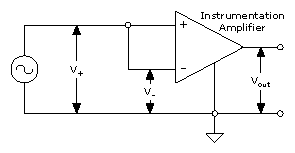Rejecting Common-Mode Voltages
An ideal differential measurement system responds only to the potential difference between its two terminals—the positive (+) and negative (–) inputs. Any voltage measured with respect to the instrumentation amplifier ground that is present at both amplifier inputs is referred to as a common-mode voltage. Common-mode voltage is completely rejected (not measured) by an ideal differential measurement system. This capability is useful in rejection of noise, because unwanted noise is often introduced as common-mode voltage in the circuit making up the cabling system.
Real-world devices have several factors, described by parameters such as common-mode voltage range and common-mode rejection ratio (CMRR), that limit the ability to reject the common-mode voltage.
Common-Mode Voltage
The common-mode voltage range limits the allowable voltage swing on each input with respect to the measurement system ground. Violating this constraint results not only in measurement error but also in possible damage to components on the device. Common-mode voltage (Vcm) is defined using the following formula:
Vcm = (V+ + V–) / 2
where V+ is the voltage at the noninverting terminal of the measurement system with respect to the measurement system ground, and V– is the voltage at the inverting terminal of the measurement system with respect to the measurement system ground.
CMRR
CMRR measures the ability of a differential measurement system to reject the common-mode voltage signal. For instance, if you are measuring a thermocouple in a noisy environment, the noise from the environment appears on both input leads. Therefore, this noise is a common mode voltage signal that is rejected by an amount equal to the CMRR of the instrument. Most DAQ devices specify the CMRR up to 60 Hz, the power line frequency. CMRR in decibels (dB) is defined using the following formula:
CMRR(dB) = 20 log (Differential Gain/Common-Mode Gain)
A simple circuit is shown in the following figure. In this circuit, CMRR in decibels is measured as 20 log Vcm/Vout, where Vcm = V+ + V–.
